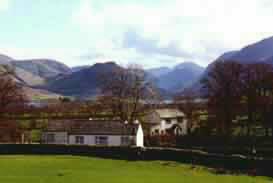
Retreat to the quiet of the Western Lakes

| An Autumn trekking holiday in India. Part 3 - The Trek along Singalila Ridge. Days: 5 to10 . . . (27th to 2nd November 2004) Trek details : Five nights, six days walking and camping along the high level route north through the Himalayan foothills along the Nepal / India border. Weather : On the trekking days the early mornings were beautifully clear but cloud built during the day. We walked in mist occasionally but only one afternoon did it rain. |
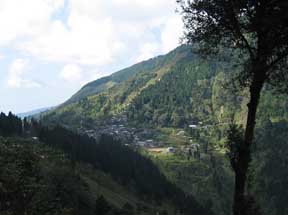 |
It was "boots on" time and the first climb of the trek from the village of Maneybhanjang, up onto the lower part of the ridge.
The walk was regarded as steep but as we followed the track and its many zig-zags up the hillside the effort was not as great as expected. At 2134 metres (6,500 ft) we were still in the lower foot hills.
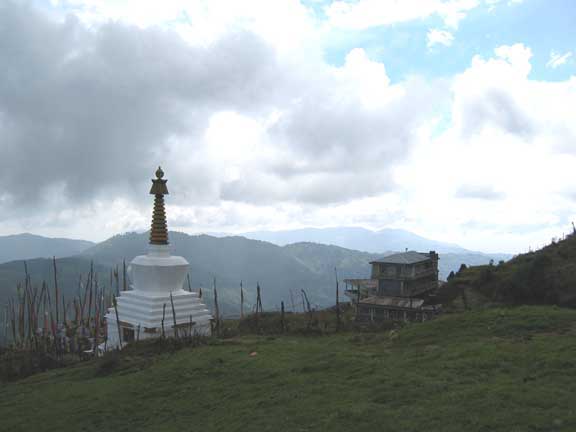
Making the ridge we passed our first Nepalese Stuppa or Shrine.
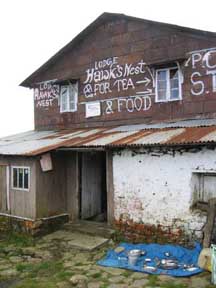 |
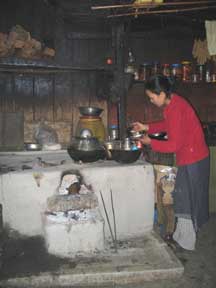 |
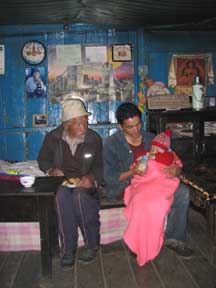 |
Tea Houses seemed to become a very important navigational landmark, and like pubs in this country, a good one should never be passed by. The Hawks Nest was our stop for lunch.
Our cooks, who had arrived before us proceeded to serve us a hot lunch (the blue groundsheet was a pleasing sign we would get to know well ) and the lady of the house served us tea while Dad and Granddad looked after the youngest member of the household.
On the wall behind them, a poster of Tower Bridge - India was full of surprises.
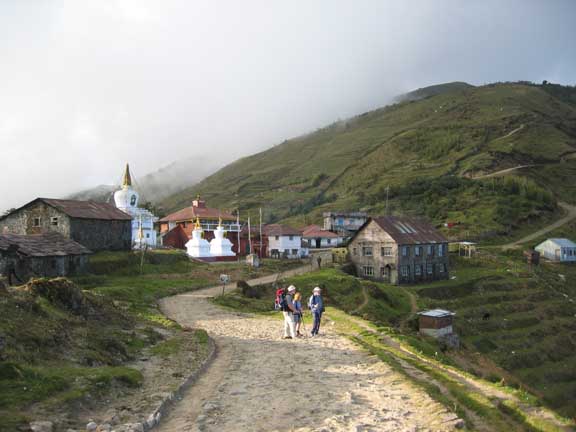
The track we followed was a semi-paved border road connecting the villages on the ridge.
Funded by the Tourism department in the sixties but no doubt also an important military highway.
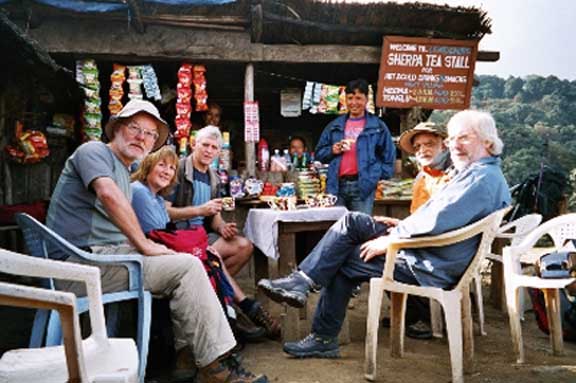
Afternoon tea at the Sherpa Tea Stall - David, Ann, Roger, Dowa, Matti and Rod.
(Photo courtesy of David Yates)
Here we were entertained by the local children, who were intrigued with our video, especially when we turned the viewing screen around so they could see themselves on camera. We have some great video moments of the children and even the mums of the village to watch now we are home.
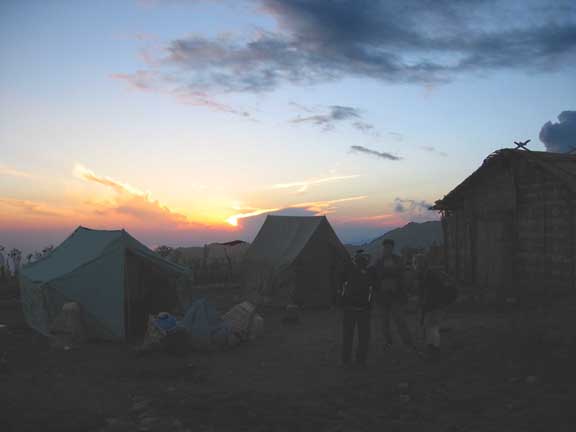
Sunset the first night and three shadowy figures stand outside the cooks tent.
What would the first night bring ?
Fortunately for Rod the night brought his kit-bag ! Having had a cancellation and a revised flight from Manchester to Heathrow his travel plans failed top coincide with those of his main kit bag. In it was all his trekking gear, his warm clothing and down sleeping bag. He had set out on the trek on the promise of it arriving tonight and fortunately it did. Full marks to Rimo Expeditions, the associate company of KE, who delivered the bag from Delhi to Bagdogra, to Darjeeling, and on to meet us on the first night, within twenty four hours of it arriving in India. Nil points for British Airways / Quantas for losing it in the first place. |
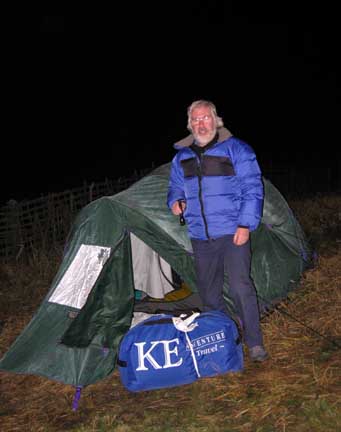 |
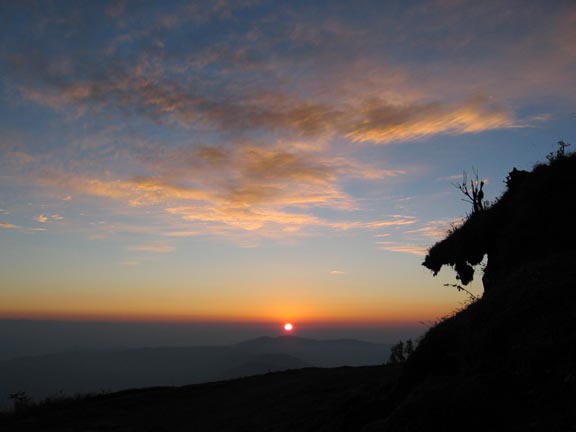
A cool night and a lumpy camping site was helped by a good tent and a thick sleeping mat
but we were awake early, so we dressed and got out in time for sunrise about 5.15 am.
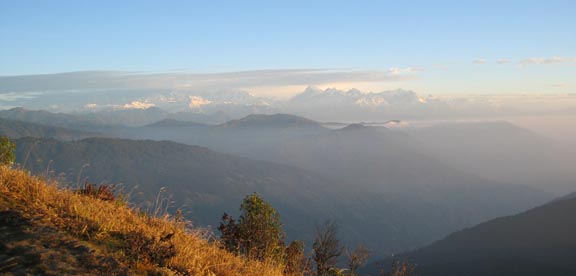
From a vantage point overlooking the campsite we got our first views of the snow covered high peaks.
It was difficult however to work out where the snow ended and the clouds started. As the days progressed the early mornings would become easier, and the mountains much more recognisable.
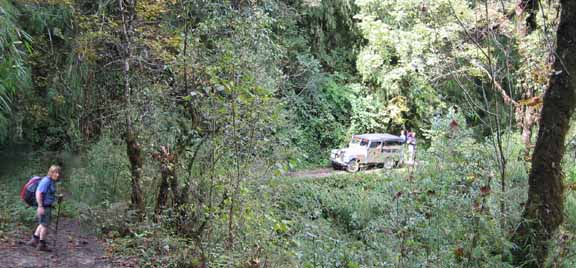
Day two took us along the lower sections of the Singalila Ridge
where the roadway passed through the Rhododendron forests, reputedly a riot of colour in the late spring. At this time of year, post monsoon, the flowers were few and the humidity high.
This road is used by the Indian tourists to access the huts and villages along the ridge. The enterprising "hoteliers" run a fleet of 1950's Land Rovers which pass us on a regular if infrequent basis. Each one was full to the brim with up to a dozen people and their bags !
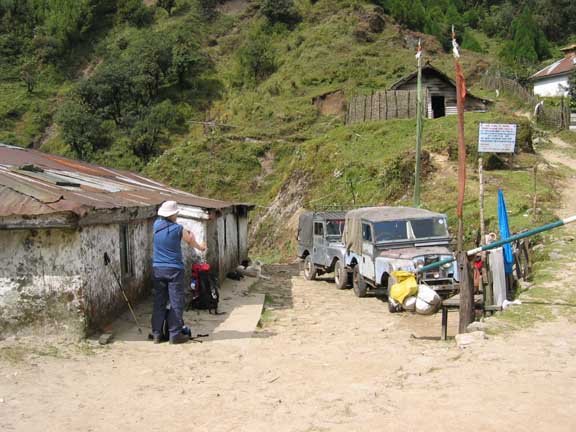
Lunch on day two at Garibas prepared by our cooks but served in one of the local village houses.
These two Land Rovers have seen better days, but have plenty more to see before they retire.
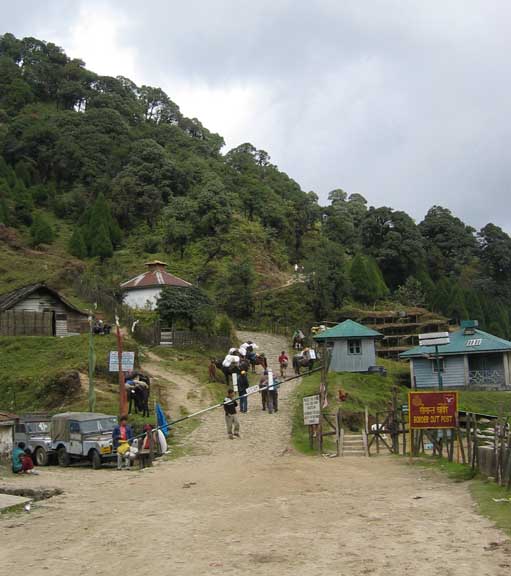
Garibas is also a border post and checkpoint along the road. Passports were again shown and names written down before we moved on up the route.
Her also is the animal sanctuary where they are attempting to re-introduce to the wild the captive bred animals born in the Darjeeling Zoo.
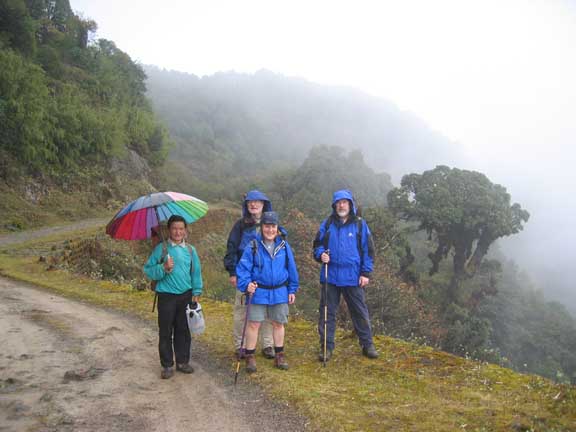
Good English weather. Po Po, David, Ann and Rod.
This afternoon was the one wet afternoon of the trip where we were even forced to take cover from a sharp hail storm.
On a technical note it is interesting to surmise which of the trekking gear is more "breathable" in these humid conditions, Dave and Rod's Gortex, Ann's Gortex Packlite or PoPo's non-gortex umbrella.
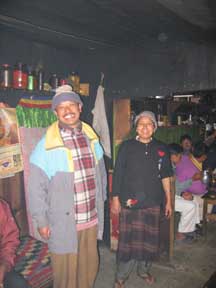 |
The evening at Kalpokhari. After a wet afternoon we dined indoors at the home of this local family. Lighting was from a six inch fluorescent strip light on a hook above us, taking electricity from a solar charge car battery on the window sill. Heat was from a bucketful of embers held in an old metal car wheel on the floor. Beer was from fermented millet seeds, made by the family and served in bamboo tankards and drunk through a straw. |
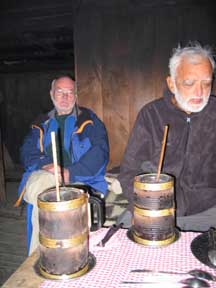 |
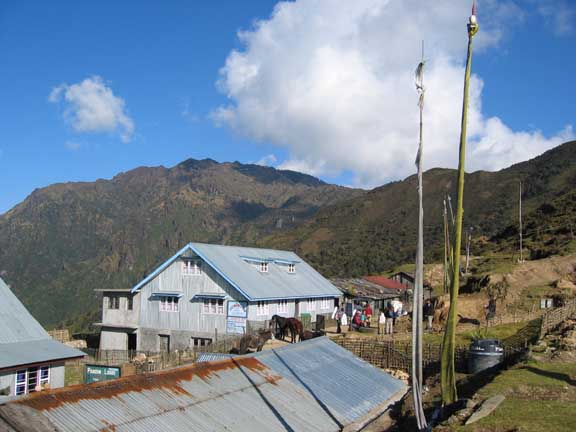
We woke on day seven to fine sunshine and a shorter walking day.
Our camp here at Kalpokhari was on the local volleyball court. From here we would climb to the highest point on the ridge ahead, some two thousand feet or less but not to be rushed in view of our altitude of nearly 3200 metres.
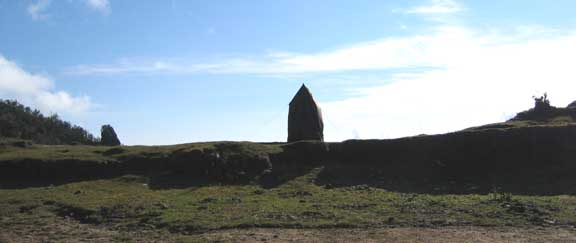
A parting shot of our loo tent standing proud above all on the top of the ridge.
Our Sherpas had the ability to place this vital piece of equipment in the most exposed and un-subtle places at times.
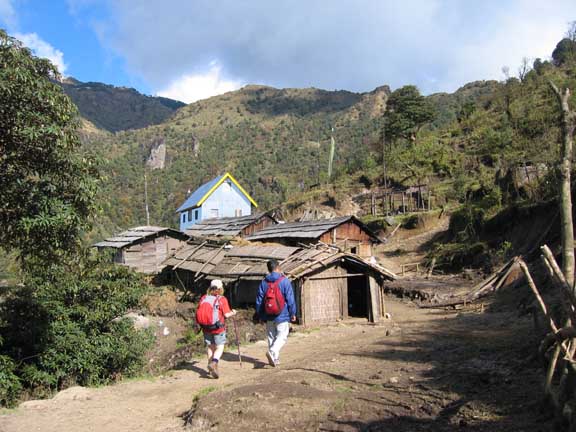
The walk to Sandakphu took us off the main track and onto the old paths and through older villages.
Here houses were made of split bamboo sheets, wooded tiles and anything that came to hand. Many used the old principle of "wattle and daub" (wattle sticks and plastered mud) reminiscent of old England in the middle ages.
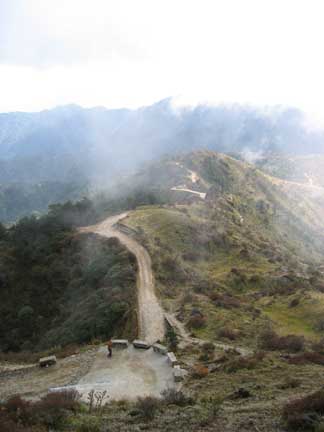 |
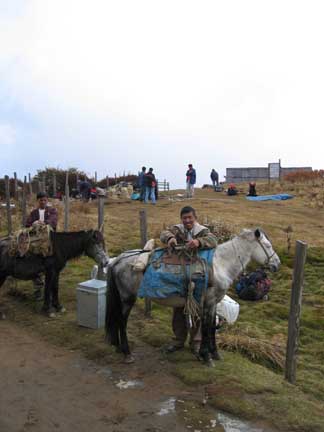 |
The final climb to the main viewpoint at Sandakphu.
Our porters arrive after us for a change and unload the horses at the camp site.
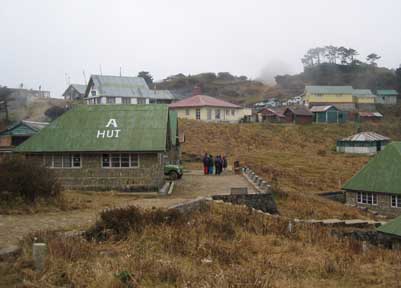 |
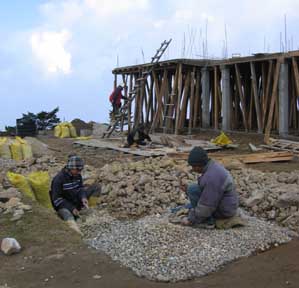 |
The afternoon was spent in the village which is the main tourist venue on the ridge.
New building is going on but if you need small stones for the cement there's no local builders merchant to order it from.
Instead you sit someone down with a big hammer to make big stones into little stones !
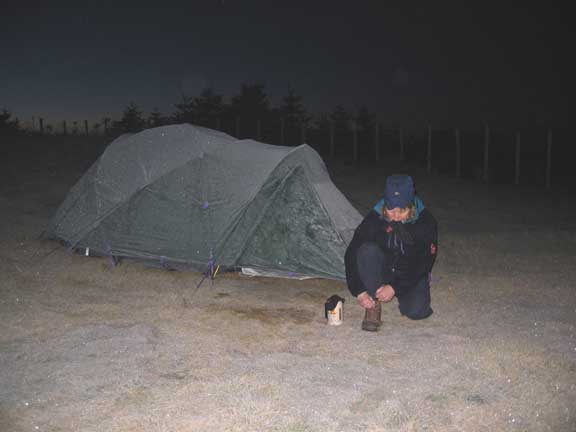
Next morning was another early one, to catch the sunrise from Sandakphu.
Ann emerges from the tent with hat, gloves, boots and her early morning "bed-tea".
Full marks to the cooks as ever.
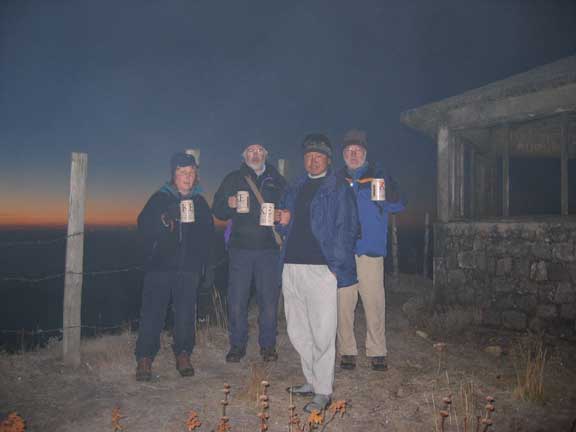
A sponsor's advertising photo.
Tea from Darjeeling, mugs from K.E. Adventure Travel.
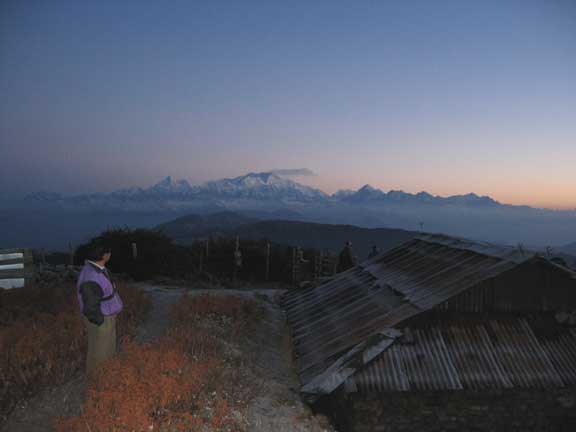
Pre- sunrise view of the mountains at first light.
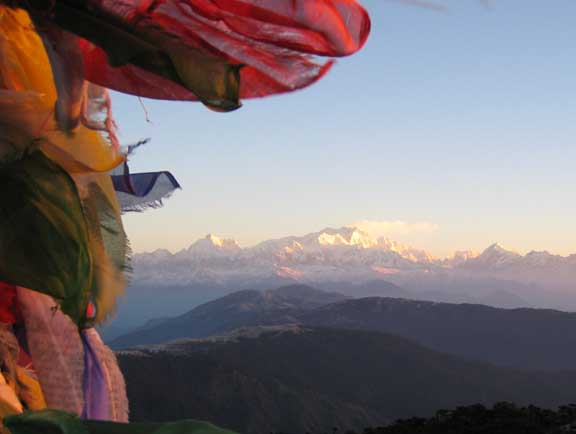
Kangchenjunga from the viewpoint above Sandakphu.
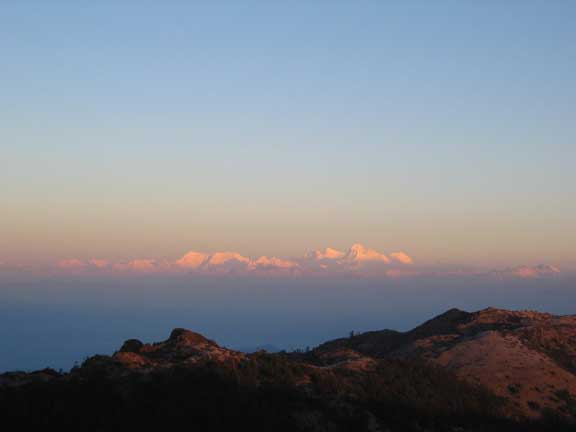
Mira Peak, Lhotse, Everest and Makalu from the same spot.
As the sun rose the distant peaks were clearly seen even though they were over fifty miles away.
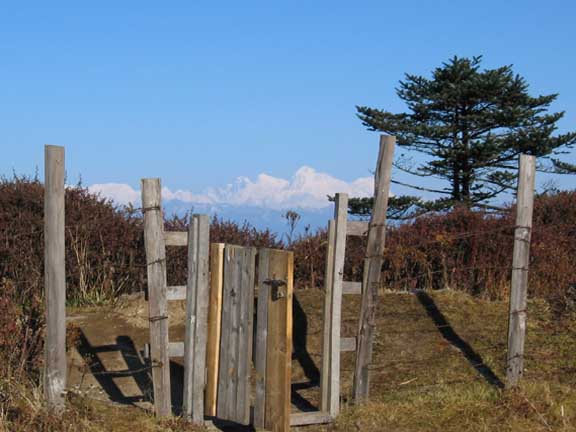
Post breakfast and full sun.
Everest over our campsite gate.

Our route for today - the high level section of Singalila Ridge
taking us closer all the time to the high peaks. This would be our longest walking day, some 23 km (14 miles).
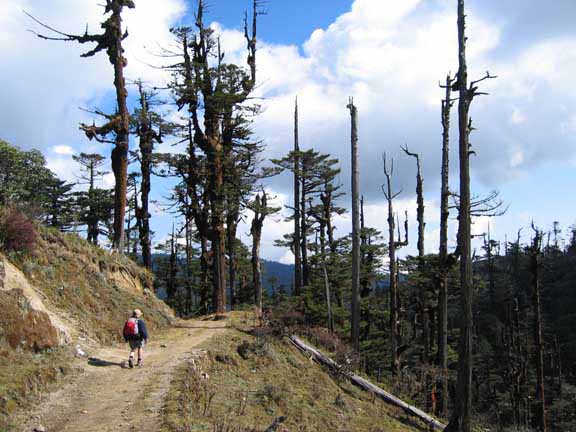
The track now is much less frequented by wheeled traffic as Sandakphu is left behind.
As the route is straightforward we are not walking as a close group. Dowa our guide leads the way and waits at significant locations (a junction, view or lunch spot) should we need to regroup. Matti is naturally slower and he and PoPo form the rear guard. Matti, although Indian, has spent the last 30 yrs in Chicago. PoPo was Nepalese and together they chat away in a sort of pigeon-Bengalese and strike up a real friendship.
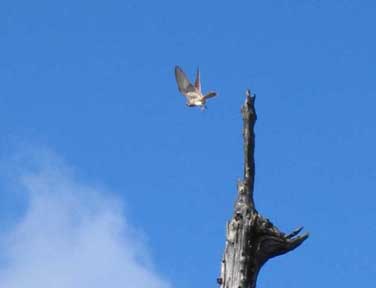 |
From the top of a tall tree a large bird of prey takes flight just as I stopped to catch a photo. Too large for a Peregrine, it had a rounded tail so possibly a buzzard or an eagle of some description. Answers on a postcard please. |
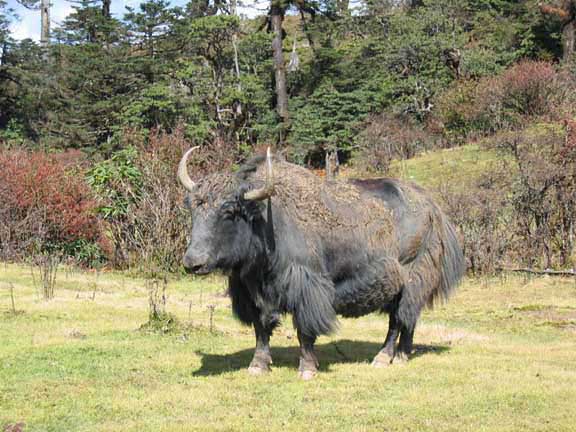
This wildlife was altogether more sedentary.
The largest of several Yaks who were grazing the pasture,
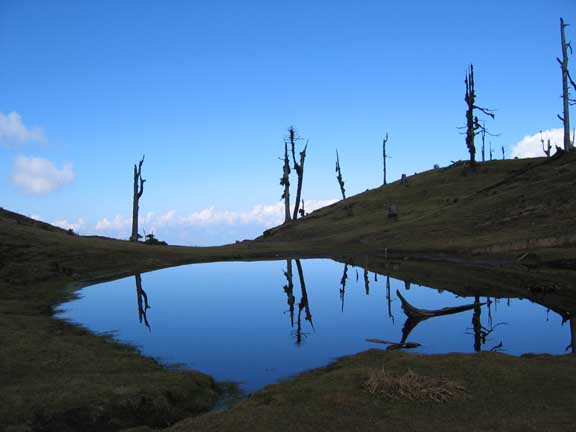
Another sunny day with perfect reflections from this small pool along the route.
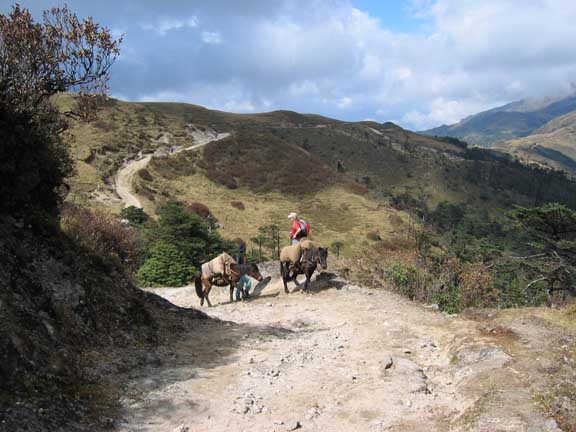
Local horses walking towards Sandakphu. They were carrying sacks of rice . Ann waits as they pass so as to allow them to use the less rough section of the road.
Ahead the last section of today's route with the prospect of climb to Phallut to end the day.
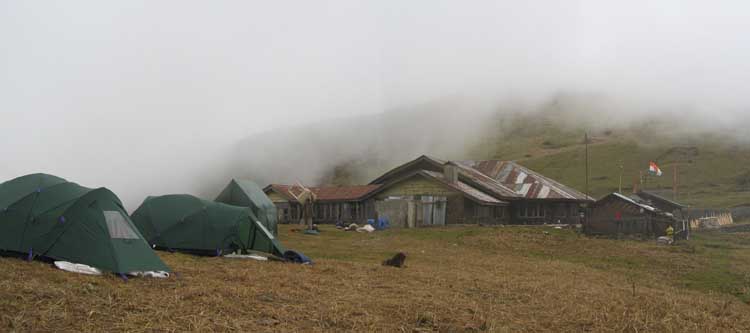
Journeys end at the trekking hut / border post / campsite of Phallut.
Our tents already erected and we were greeted by the sherpas with warm water for washing and another huge pot of tea.
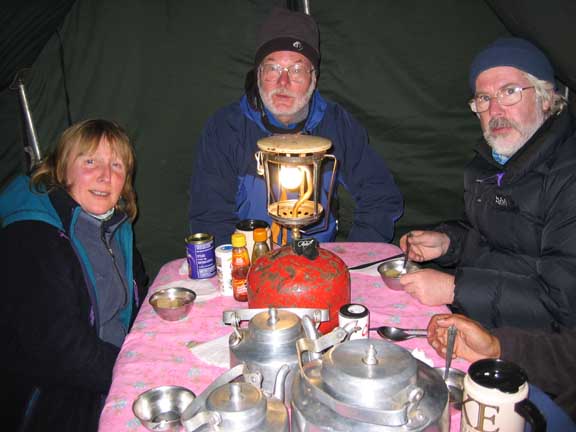
Dining in at 3600 metres. Three course diners were invariably followed up by a brew of tea or coffee.
The use of horses and a Sherpa team of eleven - not bad for five of us - allowed no comfort to be spared. The Mountain Hardwear tents were a good size for two plus kit, we had table and chairs in our own mess tent for meals, and cooking was done over kerosene stoves. When not in a back room of a hut, the sherpas slept in the cook tent.
After an hour or so reading it was time to turn in for sleep.
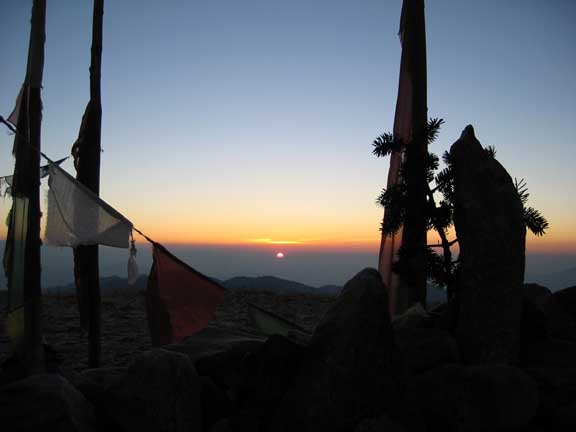
Day five of the walk, our highest point at 3600+ metres (12,000 ft) and our furthest point north.
Another early start (we were quite getting used to them) in order to walk for half hour to the summit of Phallut mountain.
There we hoped to catch our closest and best sunrise view of the holiday.
Better even than Sandakphu, our viewpoint took in the whole of the Himalayan panorama, and not a sign of Michael Palin anywhere.
Click here or on the photo for a larger version
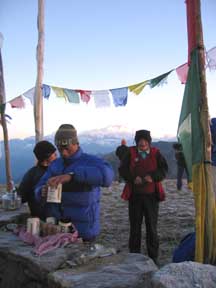 |
Hard work this trekking so Radchuma tops up our morning tea from a pot brought up from below. Ann, seems to have found and befriended a local mountain dog and shares a biscuit or two no doubt.
|
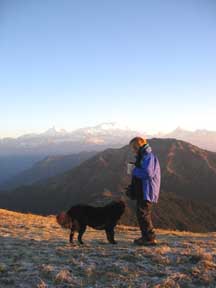 |
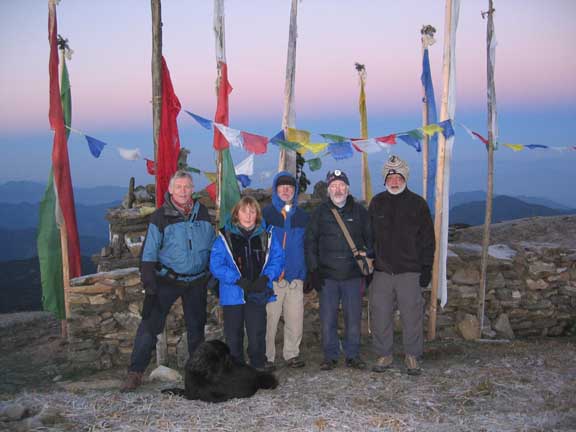
The five of us gather for a group photo at the summit shrine on Phallut mountain.
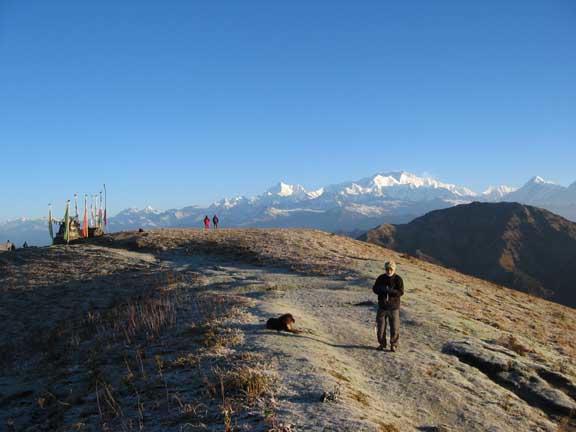
Full sun but still freezing cold we start to make our way back to camp.
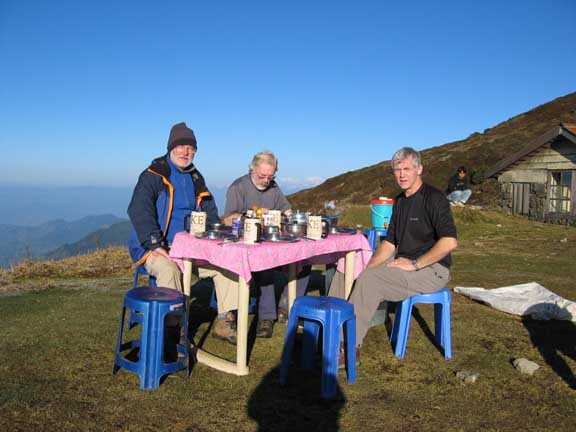
Breakfast with a view.
We abandoned the mess tent in favour of an al-fresco meal.
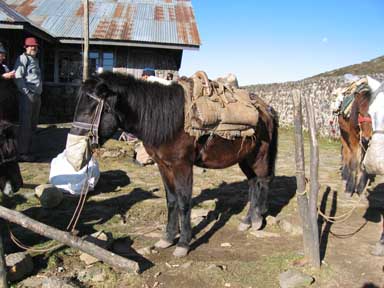 |
Horses were gathered in and fed prior to leaving the camp. From here on it would be downhill, making our way south and slightly east down into the valleys of Sikkim Province. |
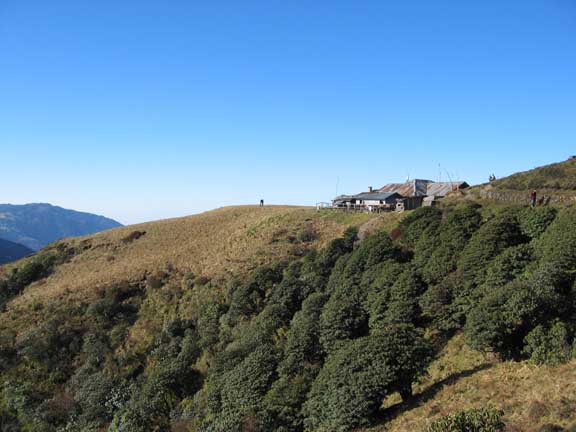
Looking back as we left at our campsite.
The tents have been cleared away and are already ahead of us.
( No that's two people - not the loo tent !)

The view east across Sikkim province to the far Bhutan hills.

South and slightly into the sun we had fine open views down towards the Darjeeling region.
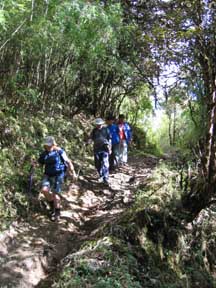 |
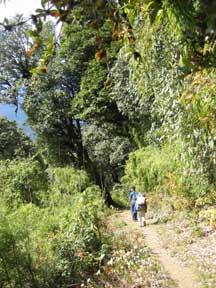 |
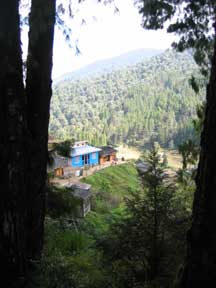 |
Down was the order of the day and as we lost height so the vegetation changed
from Rhododendrons, to Bamboo, to evergreen and deciduous trees.
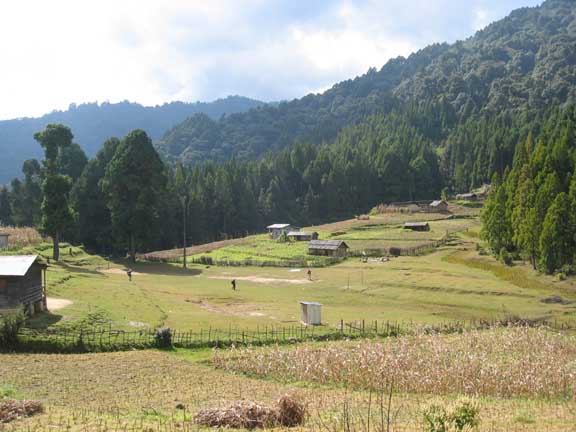
Lunch now in the village of Salamanda (spot the blue groundsheet)
The village took advantage of the more level ground to grow sweet corn and cardamom and other food and cash crops.
There was even enough space for a football pitch for the village children.
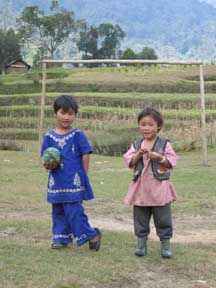 |
Despite the lack of common language we enjoyed the company of several of the local children who sat with us and looked at pictures we found in booklets or the trek brochure. Their football was made of plastic bags taped together in a ball, and we had an enjoyable wait while we waited for Matti and PoPo to arrive.
|
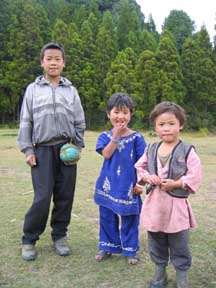 |
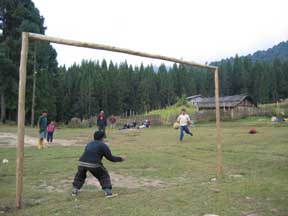 |
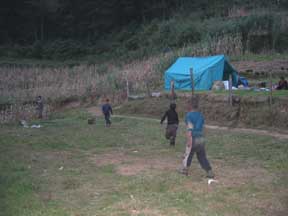 |
Lunch was on hold for them, so a larger football was found and the cooks joined us for a kick about.
That evening we joined in a game of cricket with other local kids, this time at the Ramman campsite.
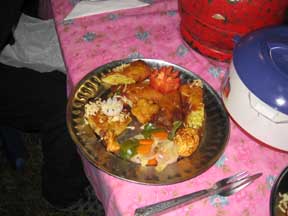 |
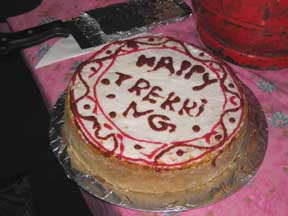 |
The last evening and the cooks made a special meal for us.
The food was always excellent quality and plenty of it. Tonight they surpassed themselves in the variety and style of the many different Indian / Nepalese dishes combined to make a "last night feast".
How they managed to provide a fresh sponge carrot cake cooked on a primus I'll never know.
but it was certainly beautifully and topically decorated.
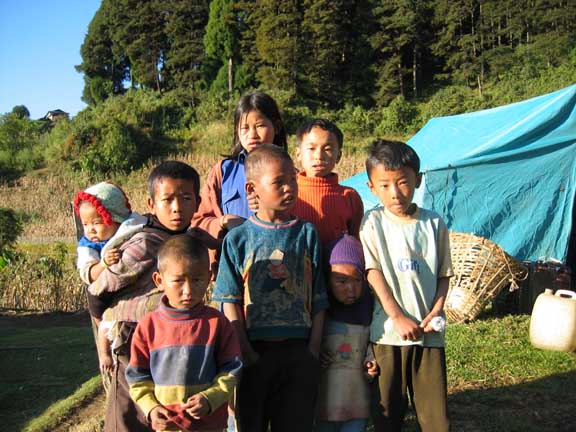
Children of the village of Ramman before we left.
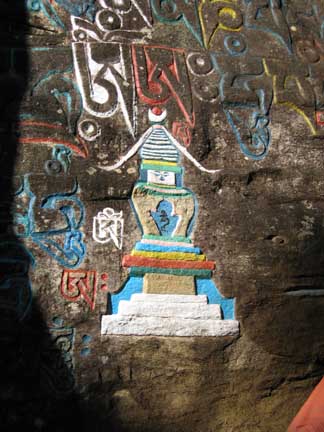 |
Buhdist decorations on a wayside rock along the way Our final trek day took us down past this painted rock shrine and on through the wooded valley towards the road head at Rimbick. |
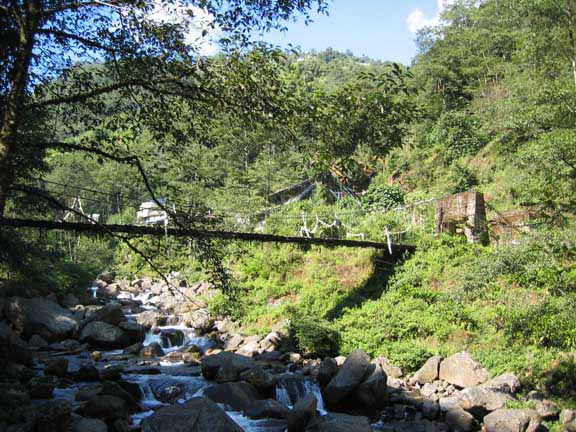
An impressive suspension bridge over the river at Siri Khola.
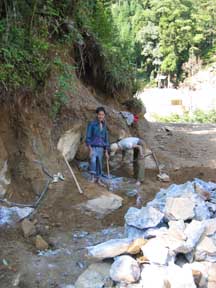 |
Road improvements of the way to Rimbick. |
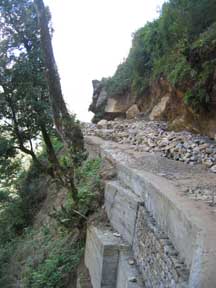 |
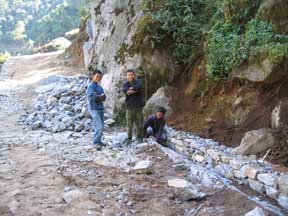 |
There appeared to be no machinery at all, and everything was done by hand. The local men, women and children were employed to dig out the rock, mix cement and lay stone to create a motor road to Siri Khola. Things will never be the same again. |
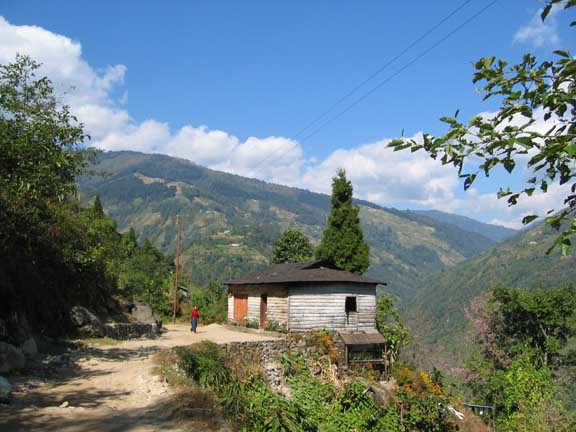
A wooden home on the roadside as we walked down to Rimbick
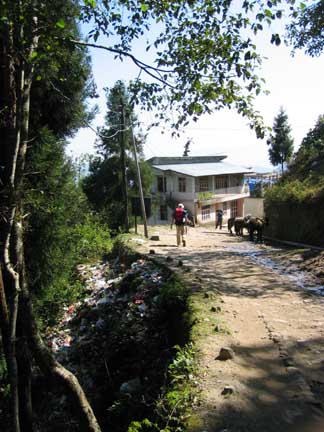 |
As we approached closer to supposed civilisation we came across better roads, then power lines and more modern houses. Cars, people and noise were once again on the agenda, and so too unfortunately was evidence of the Indian inability to deal effectively with 20th century litter. To the side of the road as we entered Rimbick the first of many piles of dumped rubbish. |
.
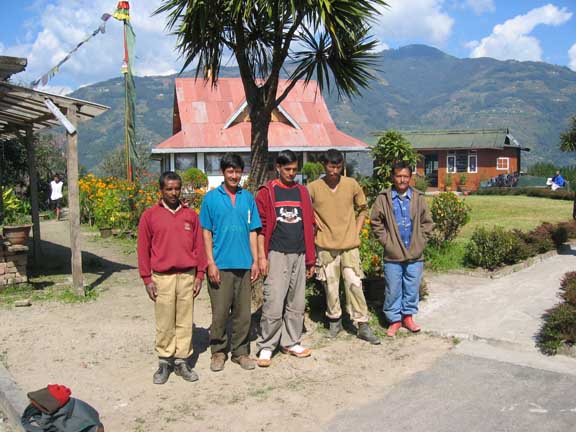
The end of the trek and time to say goodbye to our guides and Sherpas.
Here the five porters who looked after the equipment and the horses.
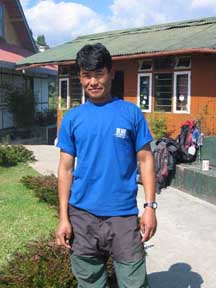 |
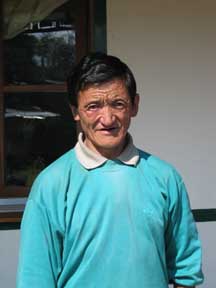 |
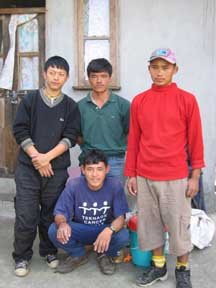 |
Goodbye also to Radchuma, PoPo, and the cooks.
A most helpful and friendlier bunch of guys you couldn't find anywhere.
Dowa, our guide would stay with us for the next part of our journey.
- - - o o o - - -
Technical note: Pictures taken with a Canon IXUS 400 Digital camera.
Resized in Photoshop, and built up on a Dreamweaver web builder.
This site best viewed . . . with fine weather and early starts.
Next Page - Go to page 1 2 3 4 5 . . . Home page . . . Go To Archive 2004
© RmH . . . Email me here